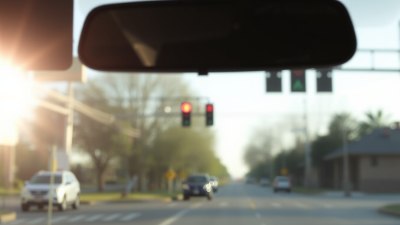How the Sun Trolls You With Glare at Red Lights
Explore why sun glare at red lights happens, its dangers, and practical tips to stay safe on the road.

Image created with Flux Schnell
Sun glare is an annoying and often dangerous phenomenon many drivers face, especially when stopped at red lights. That sudden burst of bright light can temporarily blind and distract, turning a brief stop into a challenging moment of visibility struggle. Understanding what causes sun glare, why it tends to intensify at red lights, and how to mitigate its effects can greatly improve your driving safety and comfort.
At its core, sun glare occurs when sunlight directly enters the eyes, overwhelming the natural ability to see clearly. This happens most frequently during sunrise or sunset hours when the sun is low in the sky, casting rays into the driver's line of sight. When you come to a red light, your vehicle often slows or stops in positions where the sun is perfectly aligned with your direction of sight, increasing the chance of intense glare.
Why Does Sun Glare Happen at Red Lights?
The positioning of the sun relative to your car plays a fundamental role. During early mornings or late afternoons, a driver heading east or west can encounter sunlight shining directly through their windshield. When moving, drivers often can adjust position, speed, or direction slightly to minimize direct light exposure. However, stopping at a red light fixes you in place, usually for an extended timeframe, causing the sun’s rays to hit your eyes for a longer duration.
Moreover, the glass windshield can inadvertently concentrate sunlight, focusing glare into a small angular window. Factors like dirt, scratches, and tinting level of the windshield also influence the intensity of glare. Polarized reflections from road surfaces or nearby vehicles can compound the overall harshness of the light you experience.
The Effects of Sun Glare on Driving Safety
Glare from the sun severely compromises visibility, impairing your reaction times and ability to read traffic signals, street signs, or spot pedestrians and other vehicles. When stopped at a red light, quick decisions may be needed once the light changes, and sun glare can delay your perception of the signal shift. This delay increases the risk of accidental running of red lights, rear-end collisions, or hesitations that confuse surrounding drivers.
Sun glare also induces discomfort, eye strain, and squinting, leading to headaches or fatigue over time. Prolonged exposure can reduce visual acuity and cause afterimages, where bright spots linger in vision, distracting you even after moving beyond the glare source. Clearly, glare is not just an annoyance but a significant safety hazard.
Factors Influencing the Intensity of Sun Glare at Stops
Several conditions can affect how severely sun glare impacts you when stopped at a red light:
- Time of day: Early morning and late afternoon hours are when the sun is low and most likely to shine directly into drivers’ eyes.
- Season: Around equinoxes, the sun’s angle aligns closer to the horizon, often increasing glare intensity.
- Location: Urban setups with reflective glass buildings can amplify glare. Rural roads with open skies might offer less reflection but more direct exposure.
- Weather conditions: Clear, sunny days produce the harshest glare. Hazy or overcast conditions diffuse sunlight, reducing glare.
- Windshield condition and tint: Dirty, scratched, or untinted windshields allow more light scattering and glare. Proper tinting and cleanliness help reduce glare impacts.
Practical Tips to Reduce Sun Glare at Red Lights
While you cannot control the sun’s position, you can take several proactive steps to minimize glare effects and maintain safety:
- Use polarized sunglasses: Polarization helps reduce reflected glare from smooth surfaces like roads and cars, improving visibility and comfort.
- Keep your windshield clean: Dust or grime increases light scattering, so regular cleaning inside and out is essential.
- Use sun visors strategically: Adjust your car’s sun visor to block direct sun rays before glare becomes overwhelming without obstructing your view of traffic signals or pedestrians.
- Plan driving times: If possible, schedule trips to avoid peak glare times such as sunrise or sunset hours along east-west routes.
- Increase following distance: When glare is present, visibility drops, so maintain more distance from the vehicle ahead to allow extra reaction time.
- Reduce speed appropriately: Slower speeds may help compensate for lower visibility if encountering glare in motion.
- Consider windshield tinting: Approved tinting can reduce brightness and block some UV light. Be sure it complies with local laws.
Technological Advances Addressing Sun Glare
Automotive manufacturers and tech innovators are exploring solutions that tackle glare more effectively. Adaptive windshields with adjustable tinting can darken automatically in bright light conditions, reducing glare impact without driver input. Augmented reality heads-up displays (HUDs) project important information directly onto the windshield in ways that are easier to see despite sun glare.
Advanced driver assistance systems (ADAS) can alert drivers of upcoming traffic signals or obstacles even if direct vision is compromised by glare. These systems rely on cameras and sensors less affected by bright light than the human eye, adding an extra layer of safety.
Why Not Close Your Eyes or Look Away?
It may be tempting to close your eyes or look away when the sun suddenly shines in your face. However, this is risky behavior. At a red light, scanning the environment and being ready to move when the light changes is crucial. Closing eyes or turning away can make you miss important visual cues and turn a short stop into a more hazardous situation.
Instead, use practical methods like sunglasses and visors to shield your eyes and maintain forward focus. Training yourself to relax your gaze slightly rather than squinting intensely can also reduce discomfort without losing situational awareness.
The Psychological Dimension of Sun Glare
Interestingly, the sun’s glare does more than impair physical vision; it can also affect driver mood and behavior. Bright, harsh light can increase stress or frustration, especially when waiting in traffic. This psychological toll may escalate irritability and aggressive driving once the light turns green.
Conversely, adequate shade, proper eye protection, and well-timed sun exposure can improve alertness and mood behind the wheel. Being mindful of the sun’s psychological as well as physical effects can help drivers maintain calm and patience during those inevitable glare moments.
Sun Glare in Different Climates and Environments
In mountainous areas, sun angles change rapidly due to elevation and terrain, causing intermittent intense glare patches that catch drivers off guard. Desert environments, with vast flat plains and minimal shade, maximize the risk of prolonged direct sun exposure.
Coastal regions experience unique glare conditions because of sunlight reflecting off water surfaces in addition to the road. Snowy regions pose an added hazard with light bouncing off white snow, compounding the glare intensity. Knowing these environmental factors helps drivers prepare specific sun glare countermeasures suited to their locale.
Addressing Sun Glare for Vulnerable Drivers
Drivers with certain conditions like cataracts, glaucoma, or general sensitivity to bright light need to be even more cautious. These conditions worsen with glare, reducing visual acuity and increasing discomfort.
Consulting an eye care professional about special sunglasses or coatings, using vehicles equipped with advanced glare reduction technologies, and avoiding driving during peak glare times ensure that vulnerable drivers maintain safety and comfort.
Sun Glare and Traffic Law Enforcement
Some drivers unintentionally run red lights simply because sun glare obscured the traffic signal. Law enforcement agencies recognize this issue and often recommend or require drivers to take extra precautions during high-glare periods.
In certain regions, infrastructural changes like adding anti-glare screens around traffic lights, adjusting light positioning, or installing additional signals at different heights help mitigate glare problems. Public awareness campaigns also emphasize safe driving habits to cope with glare challenges.
The Role of Vehicle Design in Combating Sun Glare
Automakers increasingly prioritize glare reduction in vehicle interior design. Windshields with built-in sunshade bands or advanced coatings minimize direct sunlight entry. Dashboard materials are chosen to reduce reflection inside the cabin.
The placement and angle of rearview mirrors have also been optimized to reduce distracting glare sources. Some cars now offer digital mirrors with cameras to provide clearer views without the hassles of traditional glass reflections.
Sun Glare and Pedestrian Safety at Crossings
Sun glare does not only affect drivers. Pedestrians crossing near intersections with direct sun exposure may find it harder to see oncoming vehicles clearly. Similarly, drivers blinded by sunlight might miss noticing crossing pedestrians.
Both parties must stay vigilant, with pedestrians ensuring they make eye contact and wait for clear signals while drivers exercise extra caution during high-glare times. Communities can improve intersection lighting designs and signage to mitigate risks from sun glare.
To handle sun glare at red lights effectively, keep these strategies in mind: wear polarized sunglasses, maintain a clean windshield, use your vehicle’s sun visor, adjust your driving schedule to avoid peak glare times, and ensure your windshield tint complies with regulations. Consider technological aids like HUDs and automatic tinting glass for long-term improvements. Stay attentive and reduce speed if glare becomes overwhelming.
By understanding why sun glare happens and adopting practical safety measures, you reduce risks and promote a more comfortable driving experience. The sun may be unavoidable, but you don’t have to let its glare control your journey.











